From dense national forests and mountains covered with snow into July to deserts that may not see rain for weeks at a time, Utah is not short on a wide variety of habitats.
On that same note, there’s no shortage of wildlife and avian diversity, starting with the millions of birds supported every year by the Great Salt Lake and extending through the sagebrush steppe, where you’ll find many of the state’s sparrows.
Here are 21 sparrow species you are most likely to find in the Beehive State.
House Sparrow
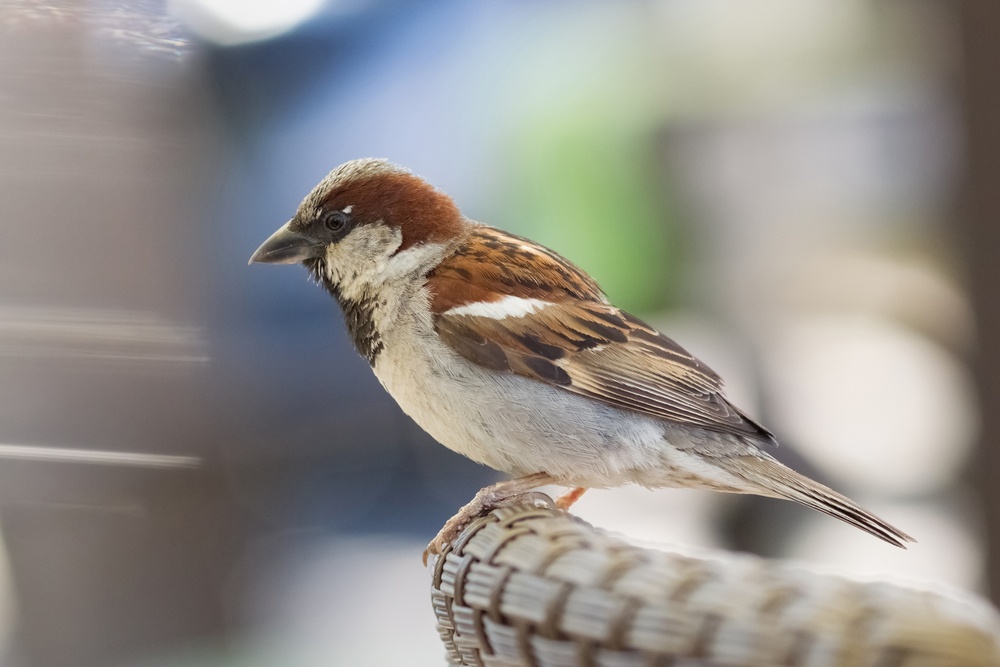
- Passer domesticus
- Length: 5.9-6.7 inches
- Weight: 0.9-1.1 ounces
- Wingspan: 7.5-9.8 inches
One of the furthest-reaching mistakes in North American wildlife history is that of the house sparrow, released in Brooklyn in 1851 to control caterpillar populations.
In the 170 years since then, house sparrows have spread across the continental United States, with an estimated 150 million of them in the country in the 1940s, according to the American Bird Conservancy, though they say that number is closer to seven million now.
Despite what seems like a sharp decrease, house sparrows are still one of the most frequently seen birds in many parts of the country.
Extremely numerous in cities and suburbs, house sparrows are typically not looked upon favorably, as they are known to directly compete with native species.
Males have stocky black bills from which black plumage extends to the eye and down through the throat and onto the chest. The back of the neck and side of the head are a chestnut brown, with gray bellies and caps.
Females have large bills with unstreaked undersides and backs. Their wings are densely striped with different shades of brown.
Black-Chinned Sparrow
- Spizella atrogularis
- Length: 5.8 inches
- Weight: 0.3-0.5 ounces
- Wingspan: 7.7 inches
We go from the non-native house sparrow and its black bib to the Southwest’s native black-chinned sparrow. A breeding resident of mostly California, Arizona, and New Mexico, the black-chinned sparrow’s range dips into the southwestern corner of the Beehive State.
Males have the namesake black chin patch, but females and non-breeding males don’t. Both sexes have pink bills and mostly gray bodies that end in a long tail.
Black-chinned sparrows have a “bouncing ball” song like some other sparrows that starts with a couple of evenly-spaced sounds before speeding up into a trill like a ball bouncing lower and lower until it comes to a rest.
Black-chinned sparrows live amongst desert scrub plants of the Southwest but come the breeding season, males may perch out in the open atop trees and brush to sing their songs.
In winter, Utah’s black-chinned sparrows will move south, with most spending the winter in Mexico.
Black-Throated Sparrow
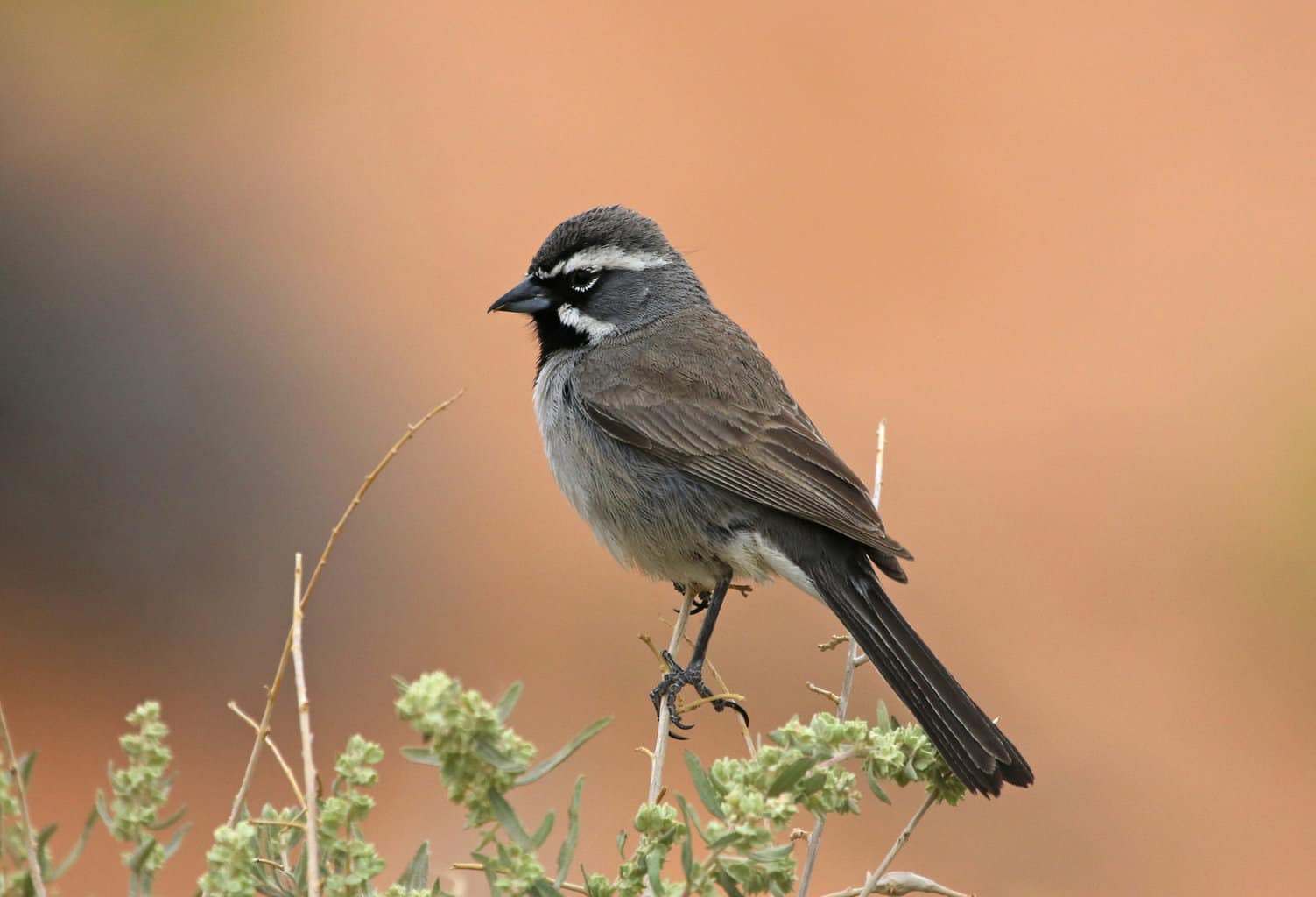
- Amphispiza bilineata
- Length: 4.7-5.5 inches
- Weight: 0.4-0.5 ounces
- Wingspan: 7.7 inches
Black-throated sparrows and black-chinned sparrows may have similar names, but they’re quite different in appearance.
Both male and female black-throated sparrows look the same, with dark black throat patches that reach the bill and two white stripes on the face, one on either side of the eye.
Black-throated sparrows are also more widespread across the state of Utah, with a range that includes much of the state outside the Uinta-Wasatch-Cache National Forest, which doesn’t provide the type of habitat conducive to black-throated sparrows.
These birds are residents of open, shrubby areas, which sounds more like the western desert and southern parts of the state and less like the tall, forested mountains of the Wasatch.
Sagebrush Sparrow
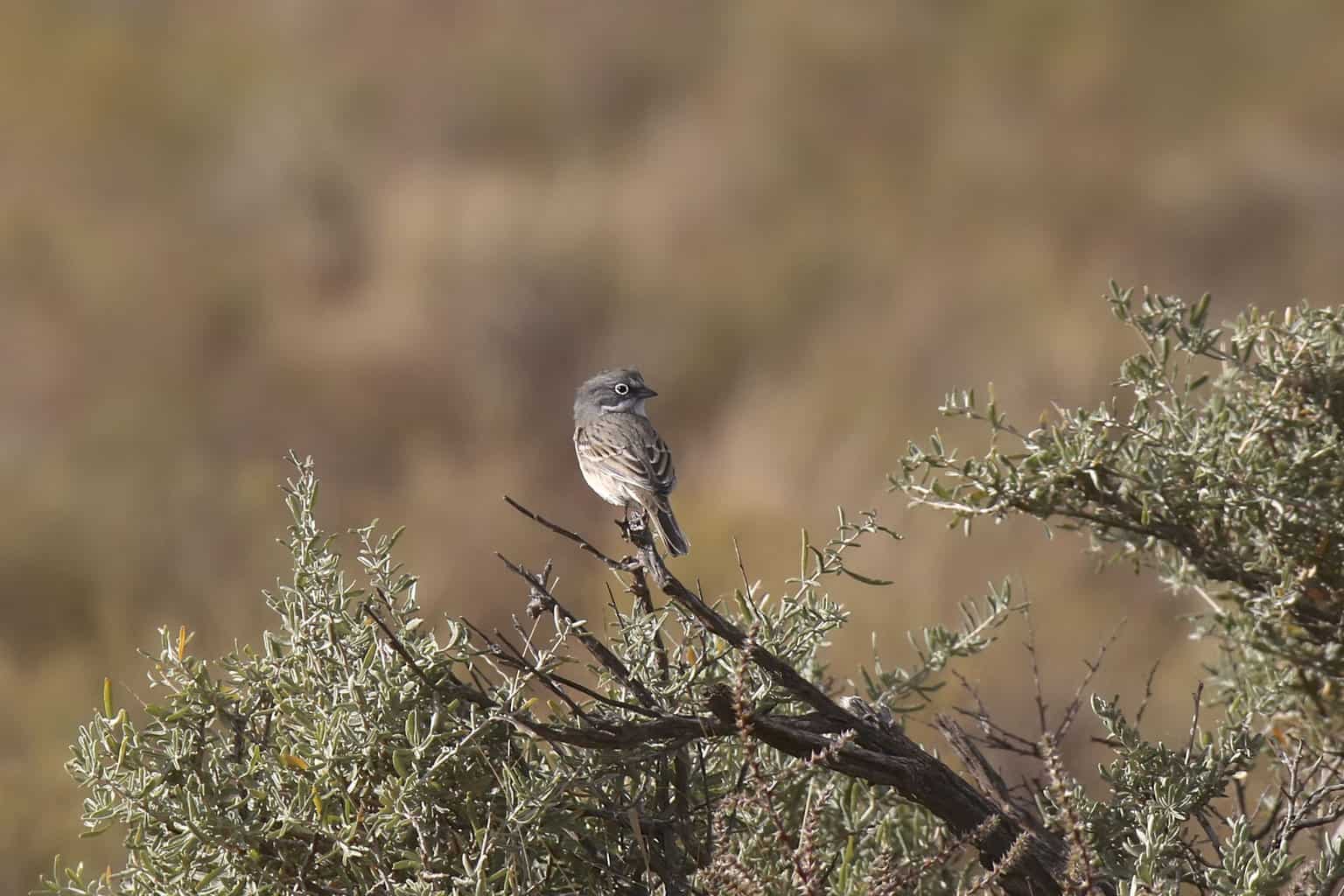
- Artemisiospiza nevadensis
- Length: 4.7-5.9 inches
- Weight: 0.5-0.8 ounces
Sagebrush sparrows are aptly named sparrows of the American West, living among low vegetation like sagebrush. Look for them on the ground, though males may sing in the open during breeding.
Sagebrush sparrow markings can be quite small, with gray heads that are mostly patternless except for little markings on the front of the face, including a white eye ring and two short white lines in the mustache and eyebrow areas.
Most reported sightings by eBird users in Utah are in the western half of the state.
Brewer’s Sparrow
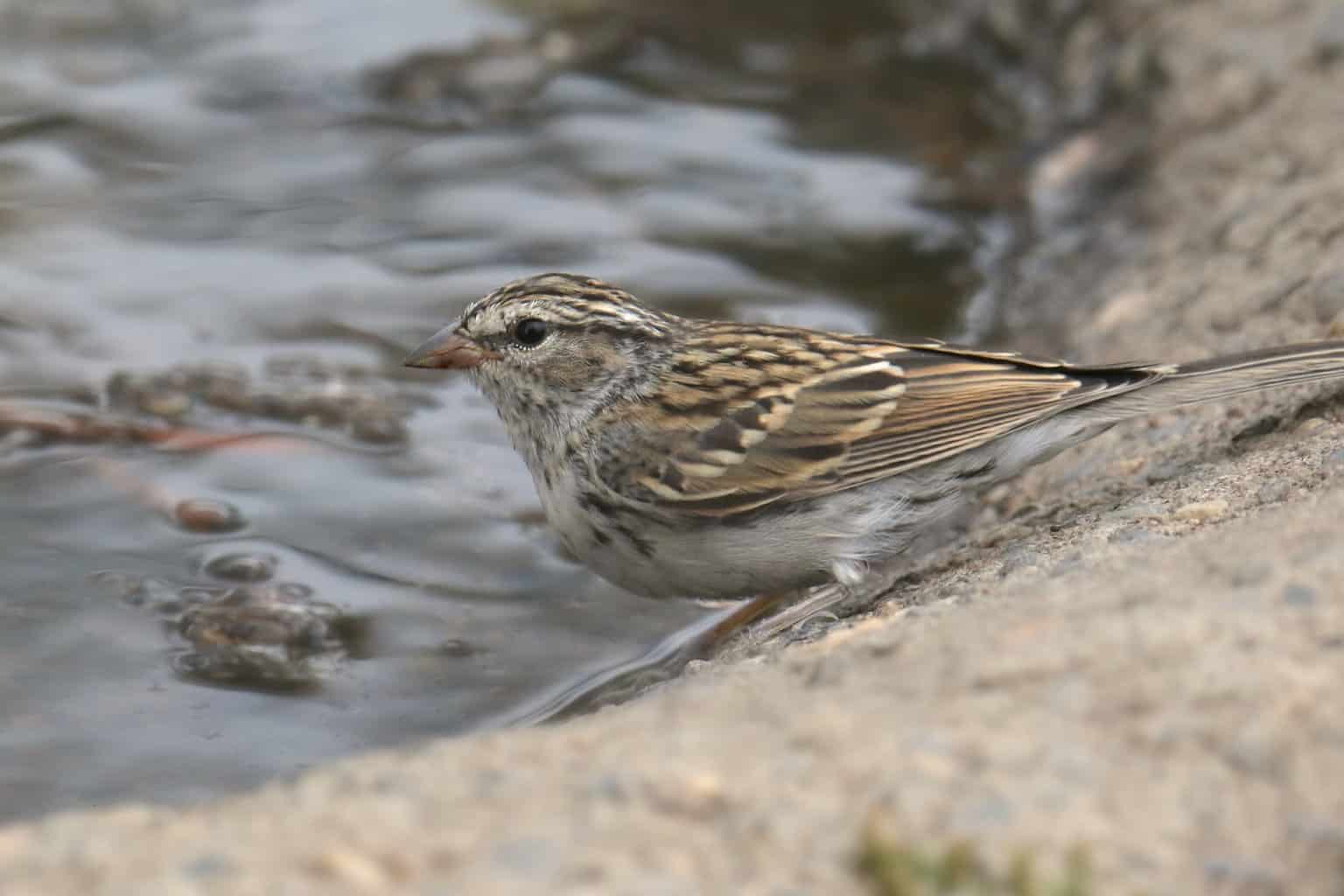
- Spizella breweri
- Length: 5.1-5.9 inches
- Weight: 0.4-0.5 ounces
- Wingspan: 7.1-7.9 inches
After some pretty unique sparrows, we have Brewer’s sparrow, which, according to All About Birds, has markings so subtle that people call it the “bird without a field mark.” However, as one of the most common birds among the West’s sagebrush, it’s a bird that many people are likely familiar with, even if they don’t know it.
They have gray, unstreaked undersides and small pink bills. Their caps are covered in thin brown streaks with a small white eyering that’s tough to see without the assistance of a spotting scope or telephoto camera lens.
Look for them among the sagebrush and listen for their complicated song that combines fast trills and chips of varying speeds that are strung together but distinctly separated.
American Tree Sparrow
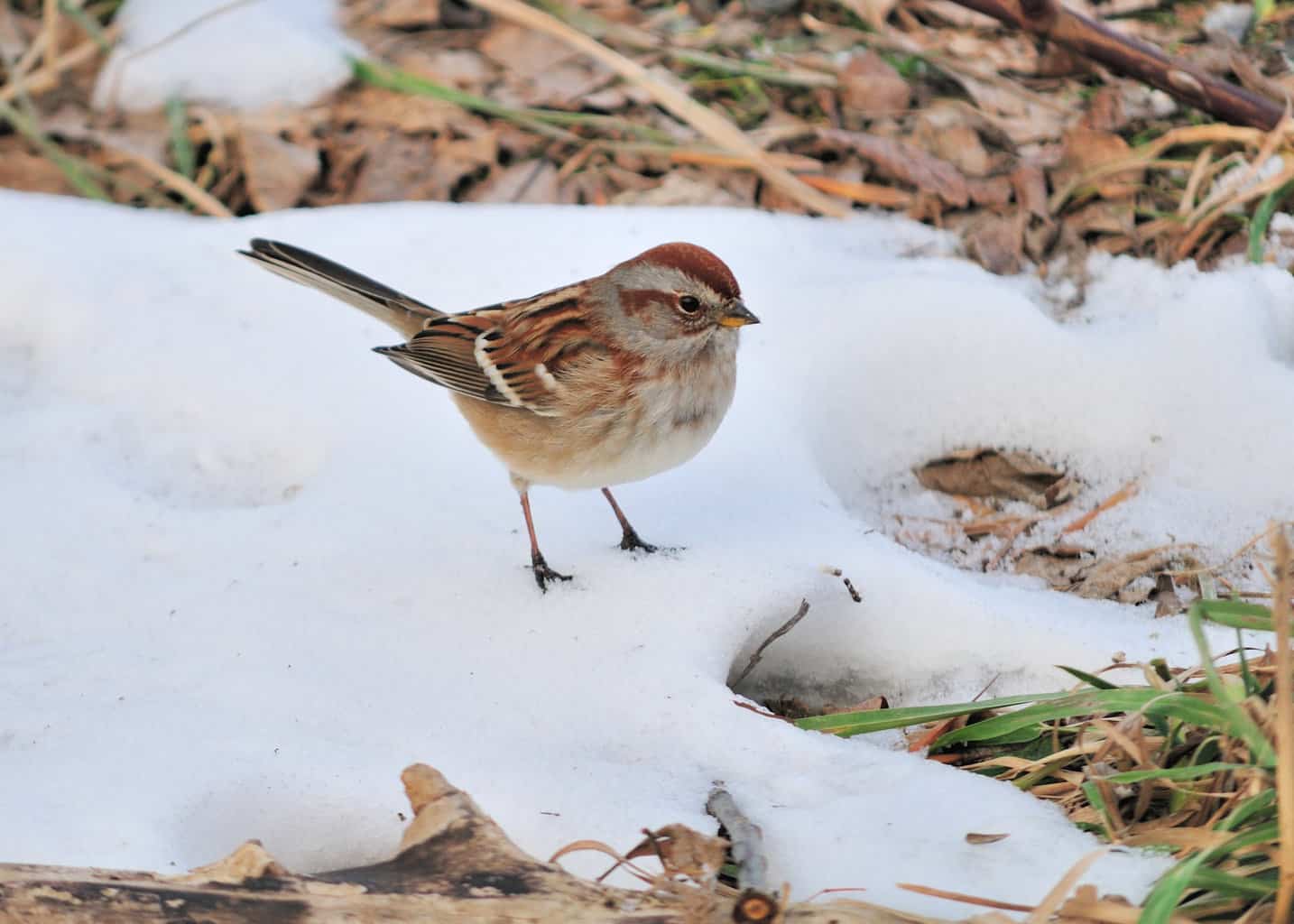
- Spizelloides arborea
- Length: 5.5 inches
- Weight: 0.5-1.0 ounces
- Wingspan: 9.4 inches
Utah is not among the top spots to see American tree sparrows, a breeder of northern Canada and a winter resident of the Lower 48, where they’re most common through the East and Midwest.
Still, there are sightings in the state each year, mainly on the ground and in low vegetation throughout the Salt Lake Valley. And don’t be fooled by their name. They’re not really tree-dwelling birds.
They have bright reddish-orange caps and a similarly colored eyeline, with a bill that’s darker on top and yellow on the bottom.
Chipping Sparrow
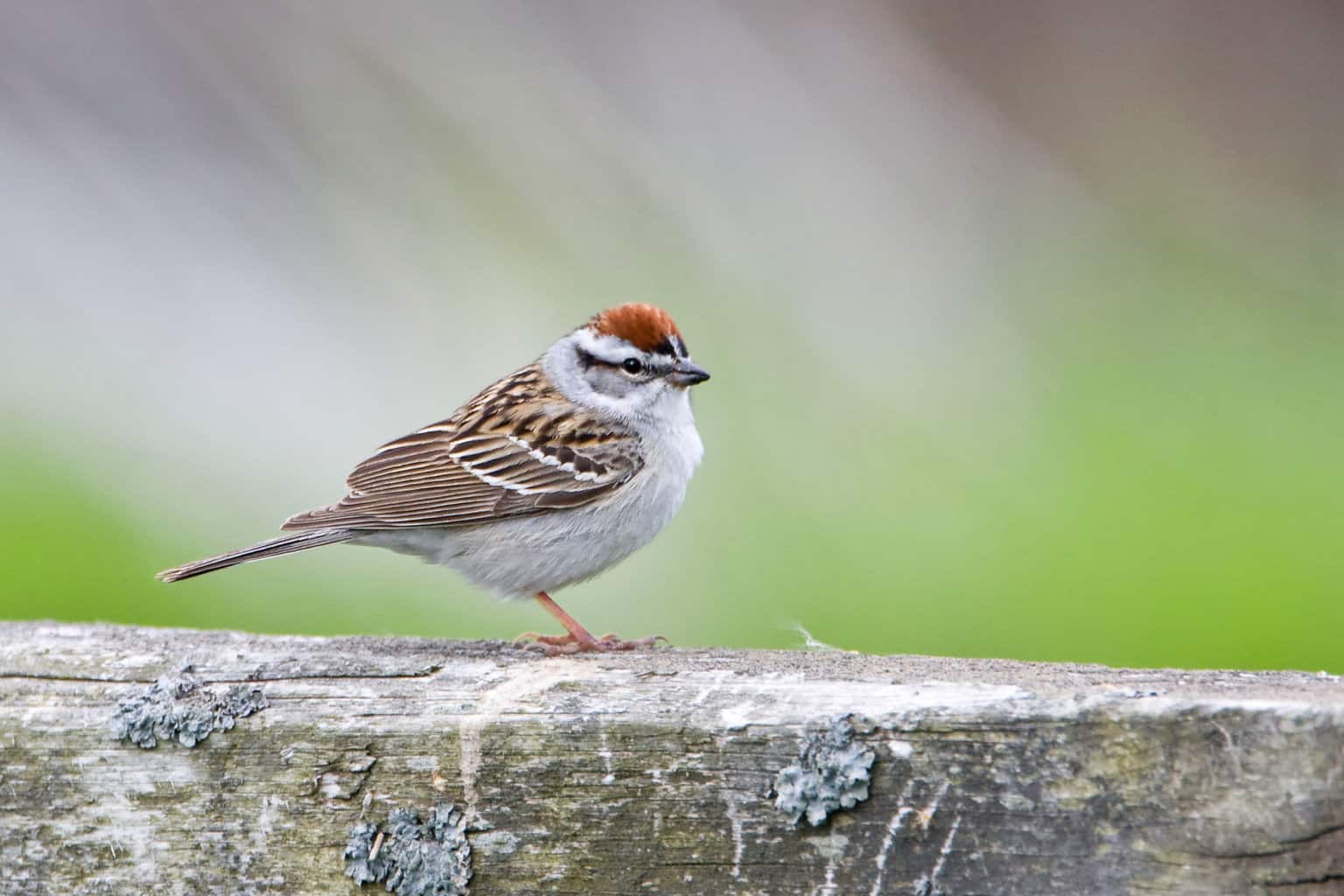
- Spizella passerina
- Length: 4.7-5.9 inches
- Weight: 0.4-0.6 ounces
- Wingspan: 8.3 inches
One of the most widespread breeding sparrows of North America, chipping sparrows can be found across the continent, from the Atlantic Coast to Alaska.
Chipping sparrows are common from forests to grasslands and are known to inhabit areas like parks and residential areas, where they will also visit bird feeders.
The male has an orangish cap and dark eyeline with a light, unstreaked underside, and a black bill.
Listen for them in the spring, when they string together chipping sounds into a trill – which averages 55 notes and 3.6 seconds, to be exact, according to All About Birds.
Single-note chips can be heard throughout the year.
Lincoln’s Sparrow

- Melospiza lincolnii
- Length: 5.1-5.9 inches
- Weight: 0.6-0.7 ounces
- Wingspan: 7.5-8.7 inches
Lincoln’s sparrow features vertical streaks from the throat set over a tan-tinged breast that meets a white, unmarked belly. A thin, light eyering and brown streaks over the top of the head are also evident.
Sightings from eBird users span the valley and southern Utah but become rarer in the West Desert, though that may be at least partially a product of having fewer people there to report sightings.
Lincoln’s sparrows are tough birds to spot as it is, often concealing themselves amongst plants close to the ground. Look for them in dense shrubs and brush.
Song Sparrow

- Melospiza melodia
- Length: 4.7-6.7 inches
- Weight: 0.4-1.9 ounces
- Wingspan: 7.1-9.4 ounces
Song sparrows are very commonly seen and heard birds throughout most of North America, including Utah, where they are year-round residents.
Starting each spring, their songs fill the air as they perch on top of a bush or small tree and sing over and over again:
Song sparrows are streaky brown birds, with thick lines running down their chests, as well as from the bill and eyes.
Their appearance varies across the continent. According to All About Birds, there are 24 recognized subspecies and 52 forms of the song sparrow, with variations in streakiness and color.
Fox Sparrow

- Passerella iliaca
- Length: 5.9-7.5 inches
- Weight: 0.9-1.6 ounces
- Wingspan: 10.5-11.4 inches
Fox sparrows are known by many Americans for their orange coloring which gives them their name, though that’s not the case for those in Utah, as this species is another one with significant regional differences.
Their thick, poorly defined streaks are a reddish-orange in much of the country, but western North America is home to the slate-colored fox sparrow, which features a gray face and back with cinnamon-brown wings and richer brown streaks down the chest.
The northern national forests provide most fox sparrow habitat. Unlike the sagebrush, shrubbery, and open areas popular with many other sparrows, is more likely to live in the forests and mountains.
Savannah Sparrow

- Passerculus sandwichensis
- Length: 4.3-5.9 inches
- Weight: 0.5-1.0 ounces
- Wingspan: 7.9-8.7 inches
The savannah sparrow’s signature mark is a little yellow one in front of and slightly above the eye that takes up a section of white space in an otherwise alternating mix of brown and white.
Some of the places where savannah sparrows are most commonly reported include marshy areas, including National Wildlife Refuges. Others include grasslands and agricultural fields.
They’re commonly spotted birds and breed in much of Utah save for some of the southwestern corner of the state, though they may winter there.
Grasshopper Sparrow
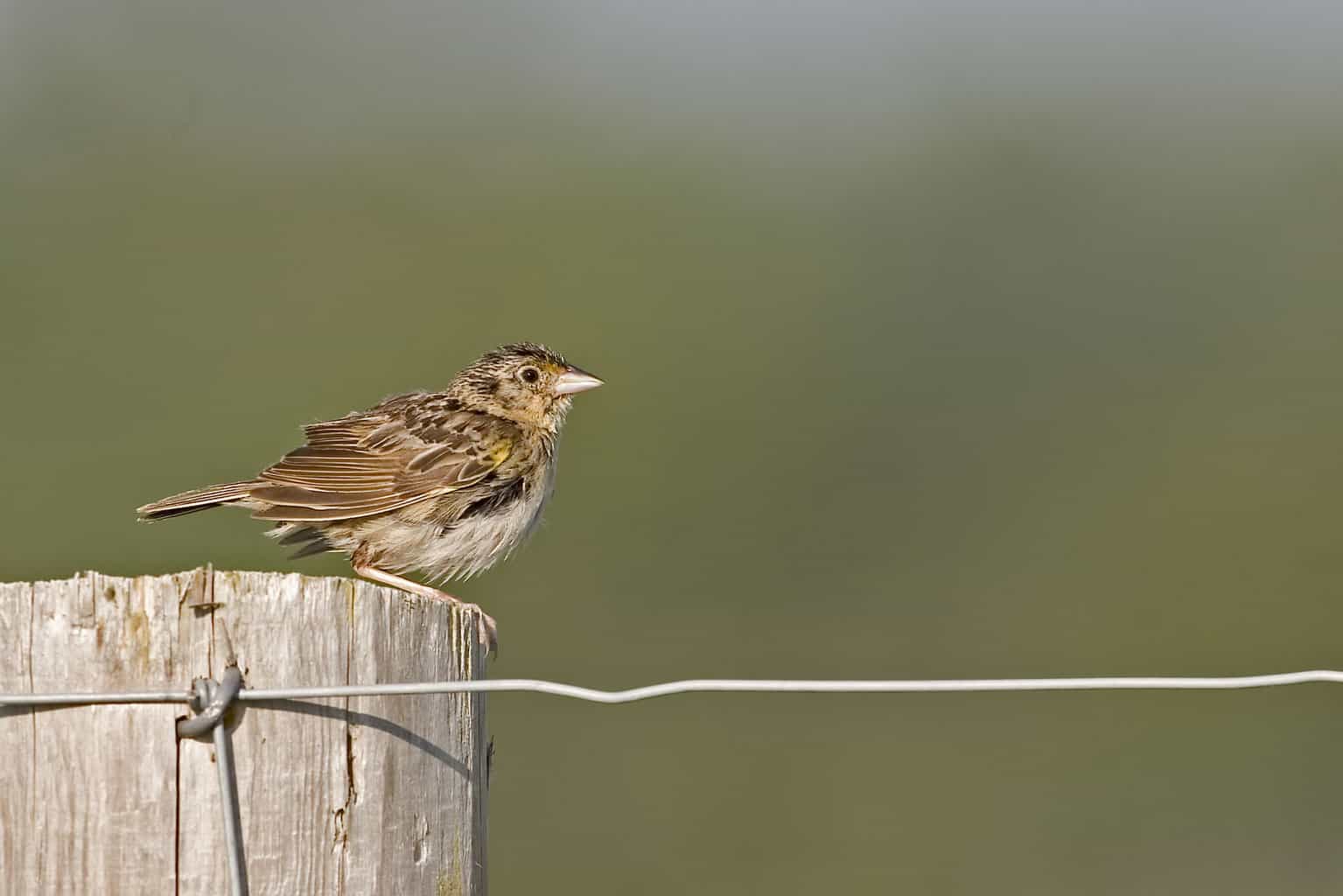
- Ammodramus savannarum
- Length: 4.3-4.5 inches
- Weight: 0.5-0.7 ounces
- Wingspan: 7.9 inches
Speaking of little yellow marks near the eyebrow…
Next up is the grasshopper sparrow, a tiny little sparrow most common in the eastern half of the United States.
They do have a relatively small western range that includes parts of northern Utah, however, with sightings spread throughout grasslands and other open areas of the Salt Lake Valley.
Generally the smallest bird on this list, grasshopper sparrows also have flat tops of their heads without much curve to them.
You can identify them by the yellow stripe in front of the eye as well as some yellow near the cheek and on the edges of the wing, though with a bird this small, that might be tough to see in the field, even with a high-powered set of binoculars or a spotting scope.
Vesper Sparrow
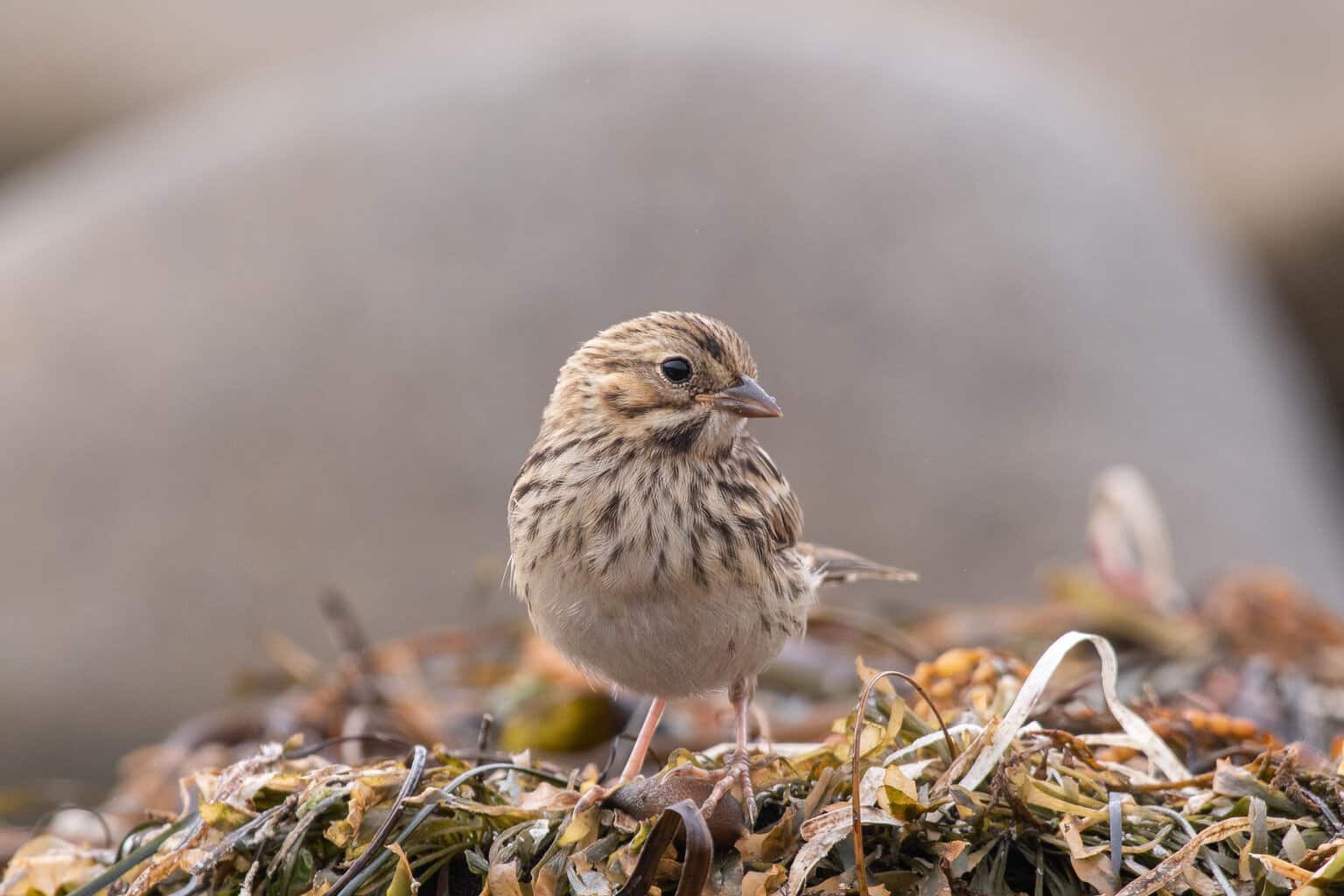
- Pooecetes gramineus
- Length: 5.1-6.3 inches
- Weight: 0.7-1.0 ounces
- Wingspan: 9.4 inches
The most distinctive mark on a vesper sparrow is a little reddish brown one near the shoulder, though it’s not always easily visible.
These larger sparrows have streaked chests with white bellies. On their faces, they have a white eye ring and white outer tail feathers.
Look for them during the breeding season in open areas like sagebrush flats, grasslands, and prairies – fitting, as their genus, Pooecetes, translates to “grass-dweller,” according to All About Birds. Though many sparrows reside in grasslands, vesper sparrows are the only member of that genus.
Its closest relative is thought to be the lark sparrow, the only member of the Chondestes genus. Speaking of which…
Lark Sparrow
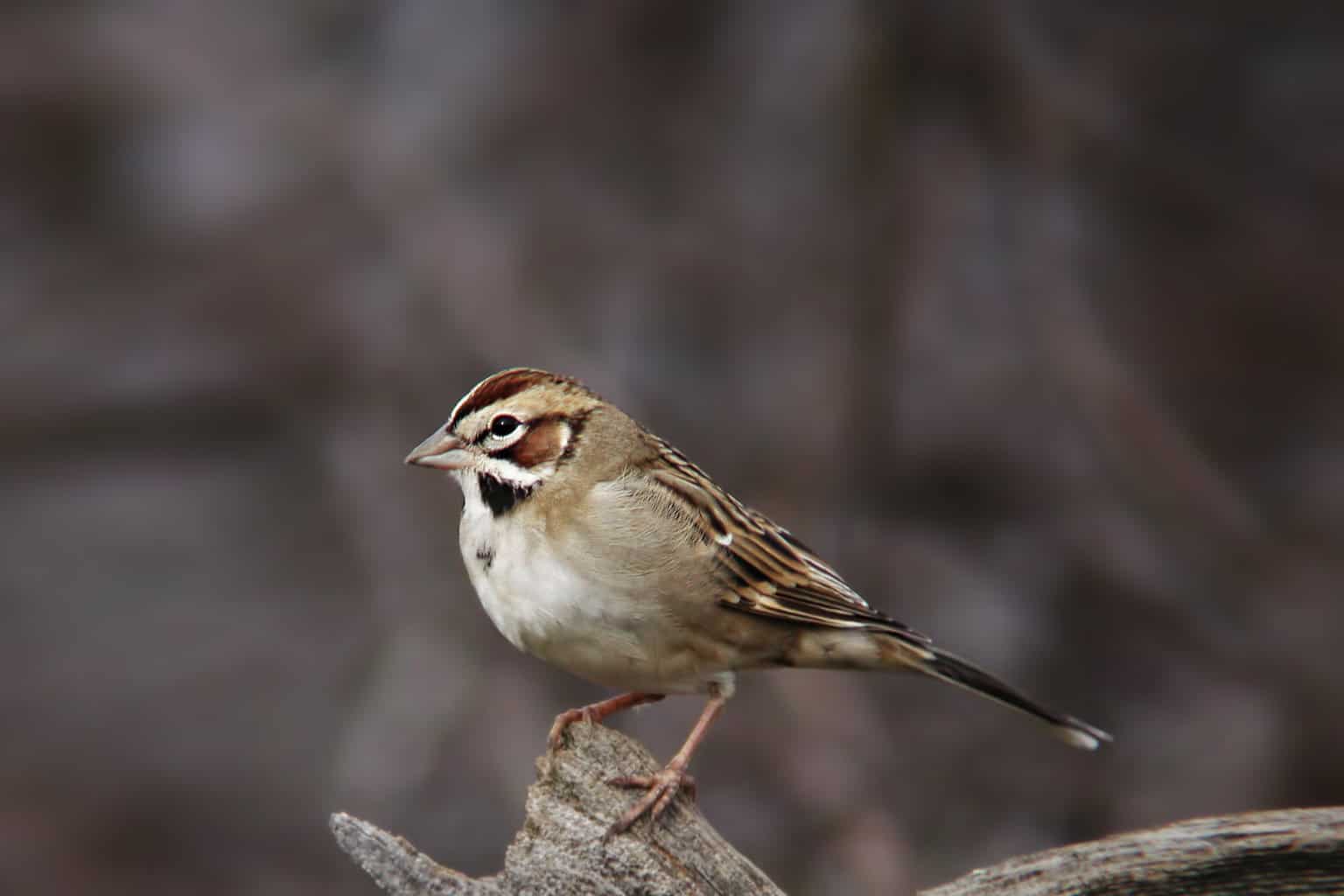
- Chondestes grammacus
- Length: 5.9-6.7 inches
- Weight: 0.8-1.2 ounces
- Wingspan: 11.0 inches
After a couple of birds that might be a little harder to identify in the field, the lark sparrow is in a league of its own, with black mustache marks, chocolate brown patches on the cheeks, a stripe through the eye, and a dark marking right in the center of the chest.
Lark sparrows are breeding residents across the Beehive State in habitats with light vegetation such as sagebrush steppe and grasslands.
As we mentioned with Brewer’s sparrow earlier, their song is a rapidly changing combination of sounds strung together.
White-Crowned Sparrow
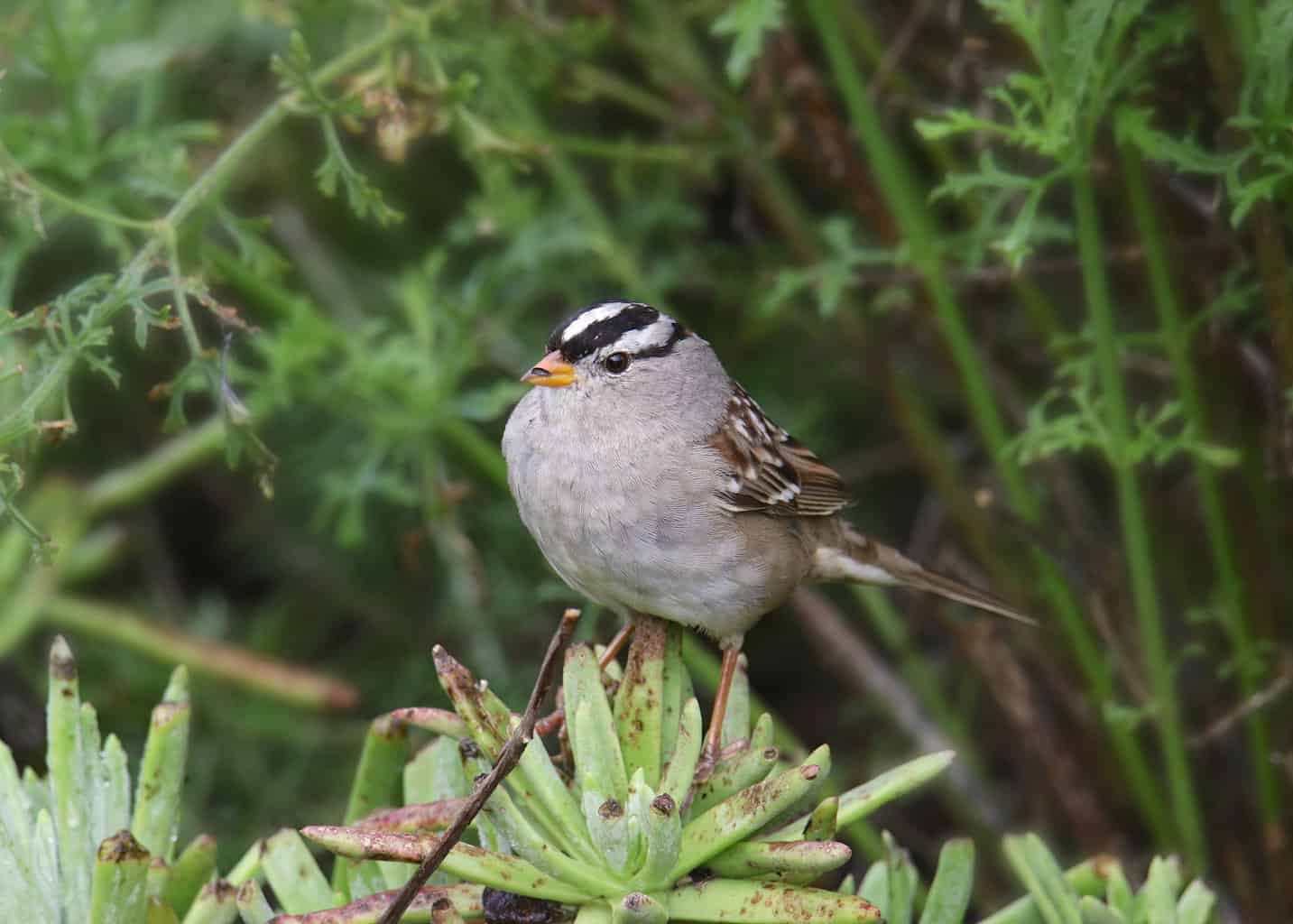
- Zonotrichia leucophrys
- Length: 5.9-6.3 inches
- Weight: 0.9-1.0 ounces
- Wingspan: 8.3-9.4 inches
For birders in many locations, white-crowned sparrows either pop up twice each year, stay for a little while, and then move on, or stay for the winter while they avoid the icy cold season in their breeding range of Alaska and northern Canada.
Areas of the Rocky Mountains, including much of Utah, have the opportunity to see white-crowned sparrows all year long in many habitats. They may even visit backyard feeders.
Their trademark is a helmet of alternating white and black starting at a black eyeline.
Rufous-Crowned Sparrow
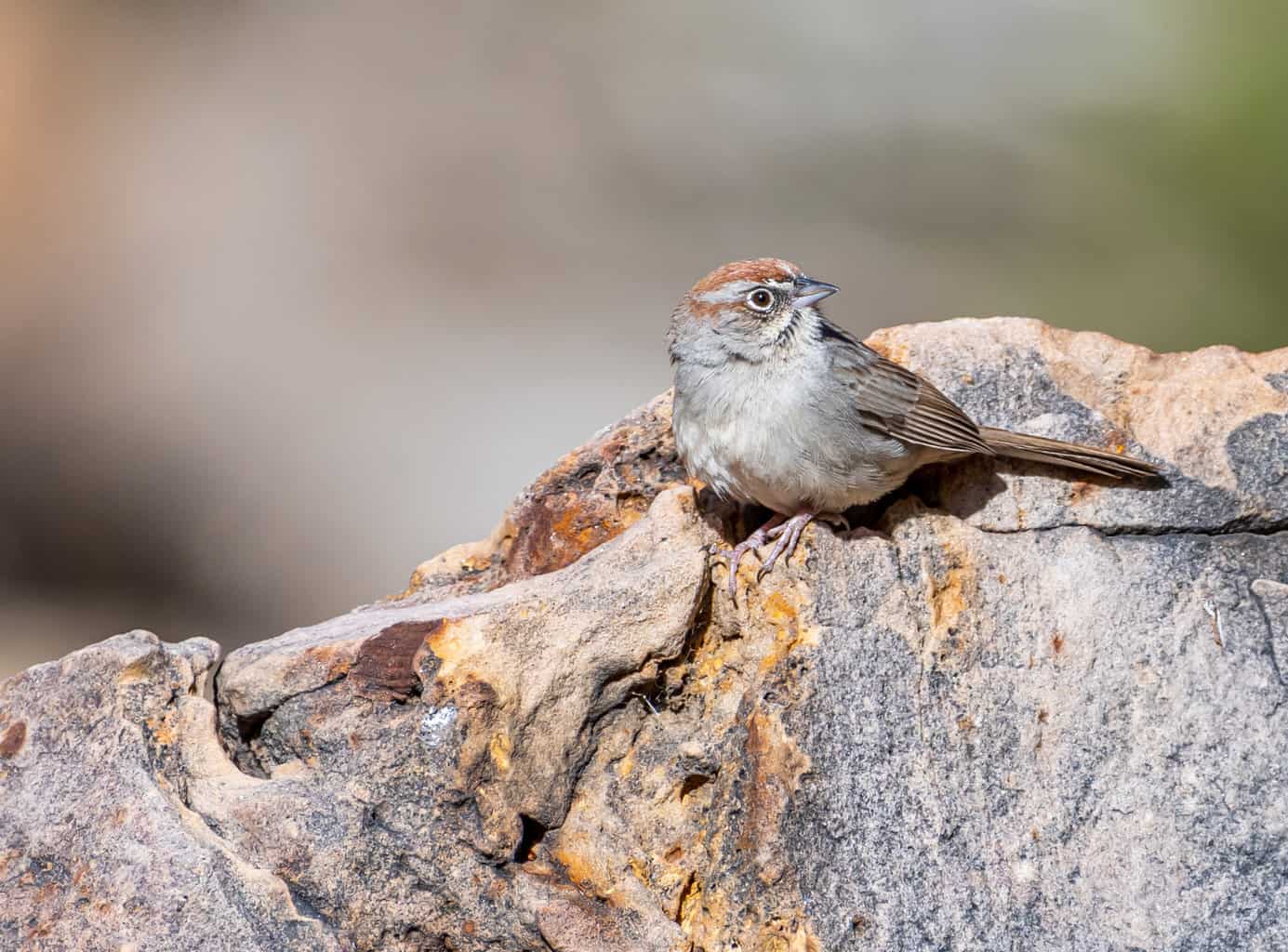
- Aimophila ruficeps
- Length: 5.9-6.3 inches
- Weight: 0.6-0.7 ounces
A resident of the Southwest, the rufous-crowned sparrow’s year-round range just barely reaches Utah’s southwestern corner, where it doesn’t expand even as far as Cedar City.
Though sightings aren’t super common, your best shot might be to keep your eyes peeled to the ground while on a hike through an area like Zion National Park.
According to All About Birds, the longest recorded flight of a rufous-crowned sparrow is just 540 feet, so you’re not likely to see them zipping around in the air much.
As their name suggests, they have a rufous cap. Their mostly gray bodies and faces feature black and white mustache markings on either side as well as a thin white eyering.
Dark-Eyed Junco

- Junco hyemalis
- Length: 5.5-6.3 inches
- Weight: 0.6-1.1 ounces
- Wingspan: 7.1-9.8 inches
Dark-eyed juncos look different all over North America, with regionally distinct color patterns.
Utahns can expect to see mostly gray-headed juncos and pink-sided juncos, relatively similar-looking birds. For most of the year, gray-headed juncos will be more common, but as red-backed juncos start to move south from states like Montana, some will stop for the winter in Utah.
Look for little gray sparrows along the ground with red on their backs (more so on the red-backed variety). They have black markings around the bill, which is a light color for gray-headed juncos and darker for red-backed juncos.
Lark Bunting
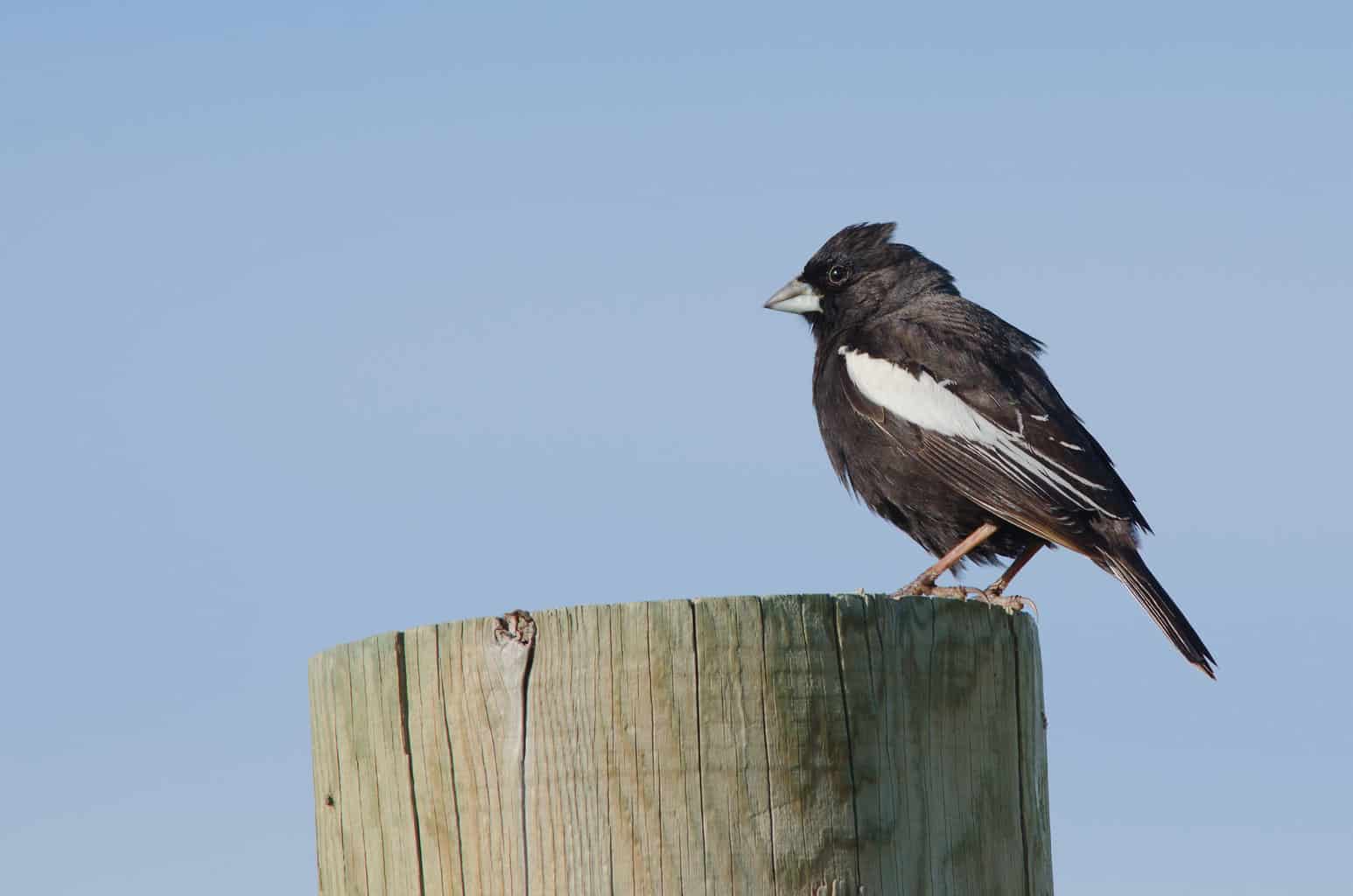
- Calamospiza melanocorys
- Length: 5.5-7.1 inches
- Weight: 1.3-1.5 ounces
- Wingspan: 9.8-11 inches
Most sparrows on this list are mostly brown, but that’s not the case for the male lark bunting, a mostly black sparrow with white edges on its wings. Their gray bills are larger than most sparrows.
Females look more like a traditional sparrow, with streaky brown undersides. They have white wing patches that adorn the shoulder area in flight and like males, they have bulky gray bills.
Sightings in Utah are sporadic, as this is a species more frequently found throughout the Great Plains states.
Spotted Towhee
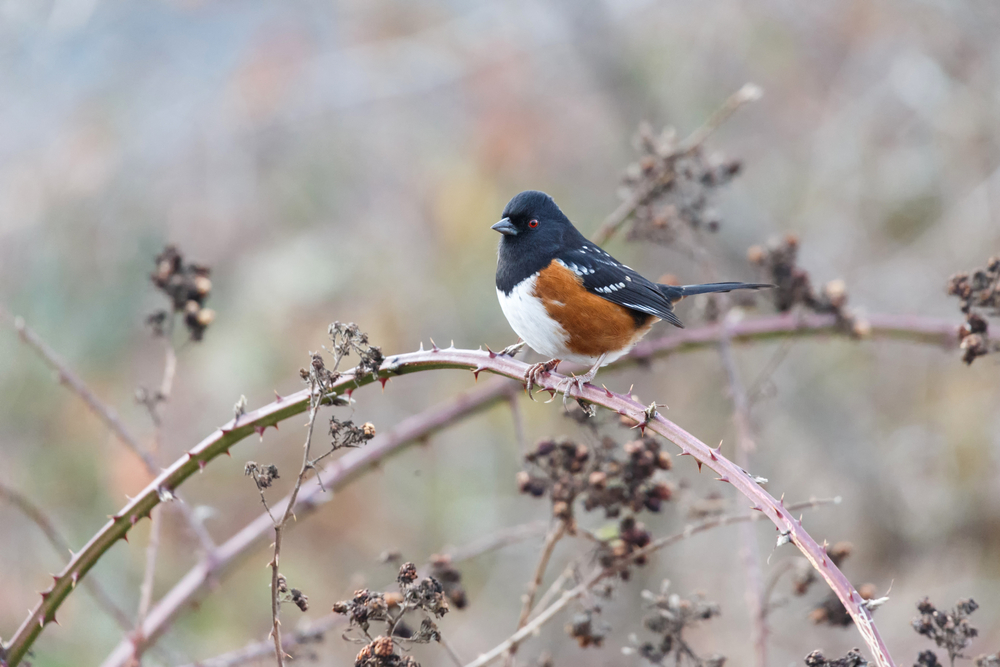
- Pipilo maculatus
- Length: 6.7-8.3 inches
- Weight: 1.2-1.7 ounces
- Wingspan: 11 inches
Spotted towhees are relatively large sparrows common throughout the West in open habitats like fields as well as lightly forested areas. They’re most commonly seen hopping on the ground.
Rusty orange sides and a white belly are the top identifiers of a spotted towhee. Males are jet black with white spotted wings. Females are brown whereas males are black. Both sexes have red eyes.
Sightings from eBird users litter the map from elevated habitats in the Beehive State’s northern national forests to the national parks of the south.
Abert’s Towhee

- Melozone aberti
- Length: 8.3-9.1 inches
- Weight: 1.5-1.9 ounces
- Wingspan: 10.4-11.6 inches
Abert’s towhee is generally a bit bigger than the spotted towhee, with a big, light-colored bill and a dark face against a mostly brown, relatively unmarked body.
The area around St. George is pretty much the only place to find this bird in Utah. Their range just barely extends outside of Arizona into bordering states and Mexico.
Look for them along rivers and stream banks. Around St. George, most sightings reported by eBird users follow the Virgin River and Santa Clara River.
Green-Tailed Towhee
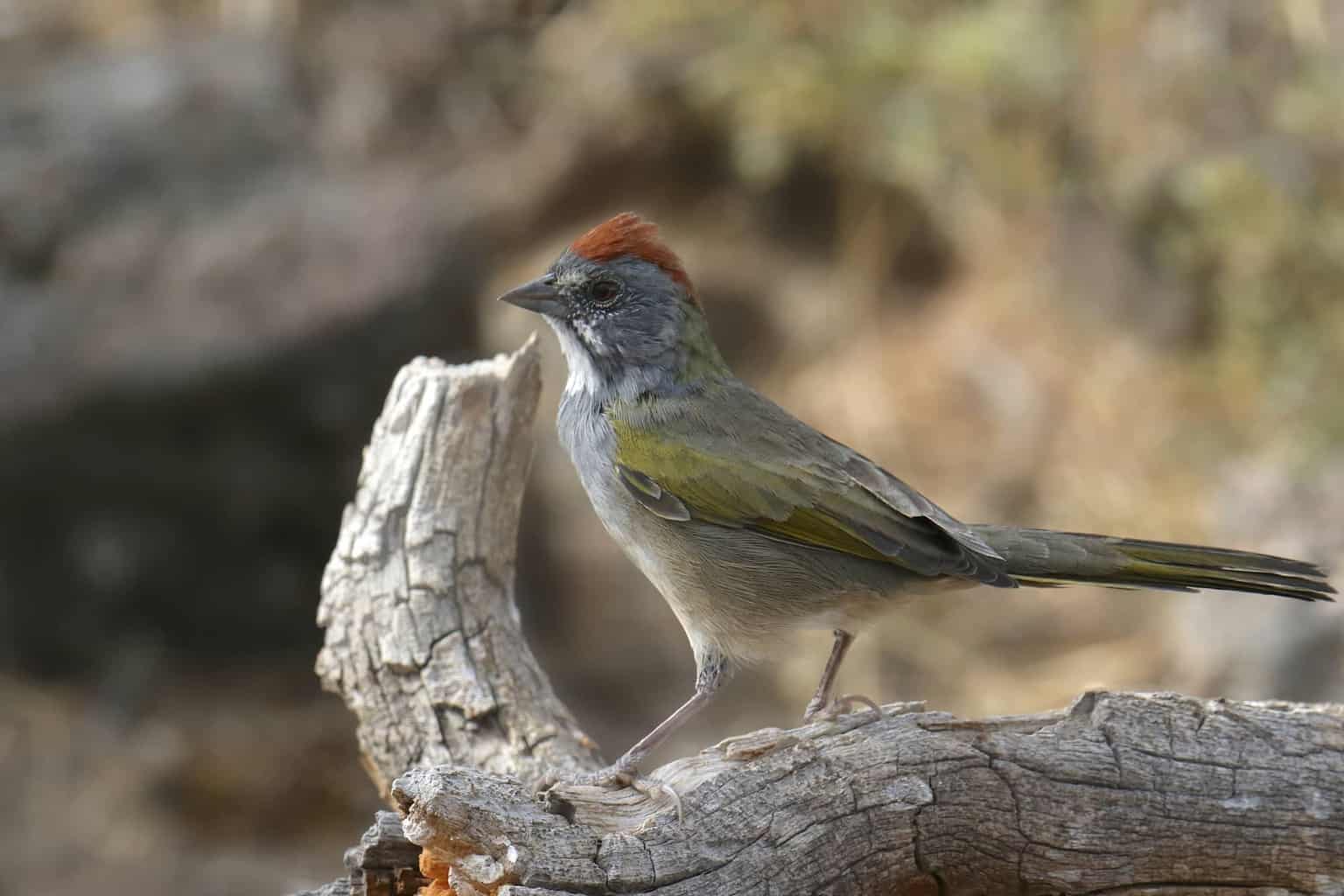
- Pipilo chlorurus
- Weight: 0.8-1.4 ounces
The green-tailed towhee features more of the traditional sparrow’s size and shape than Abert’s towhee or the spotted towhee, with several very unique markings.
Beyond their rufous orange cap and white markings under the bill, their olive-green wing and tail colors serve as this beautiful bird’s signature style.
Many sightings in Utah come from the Wasatch range and surrounding towns, although they can be found across the state in various habitat types.

